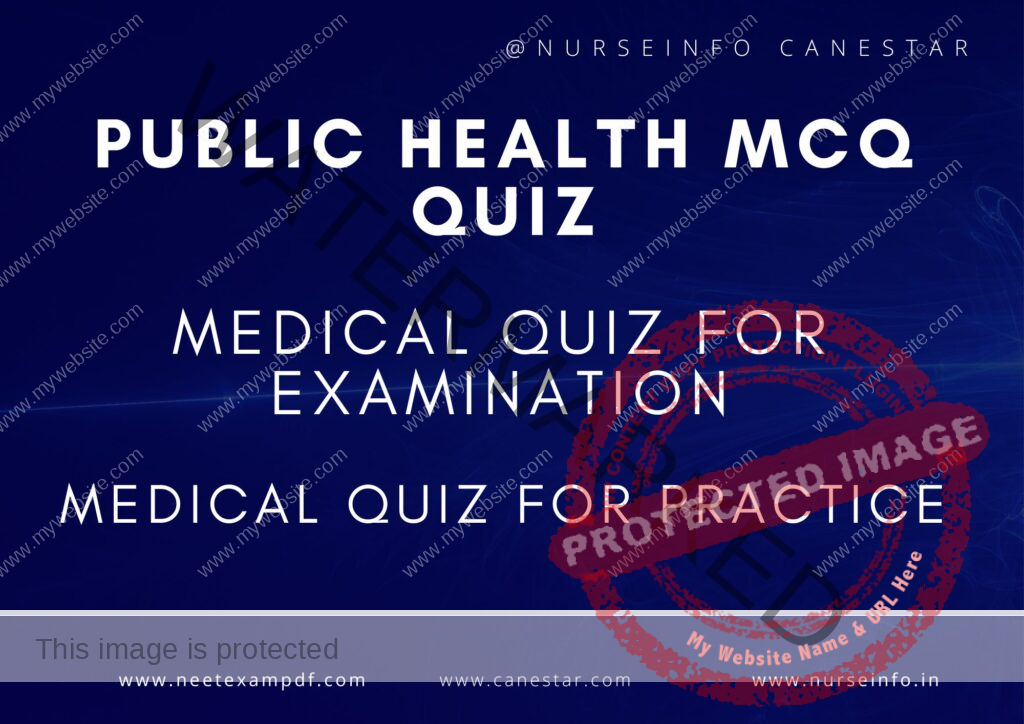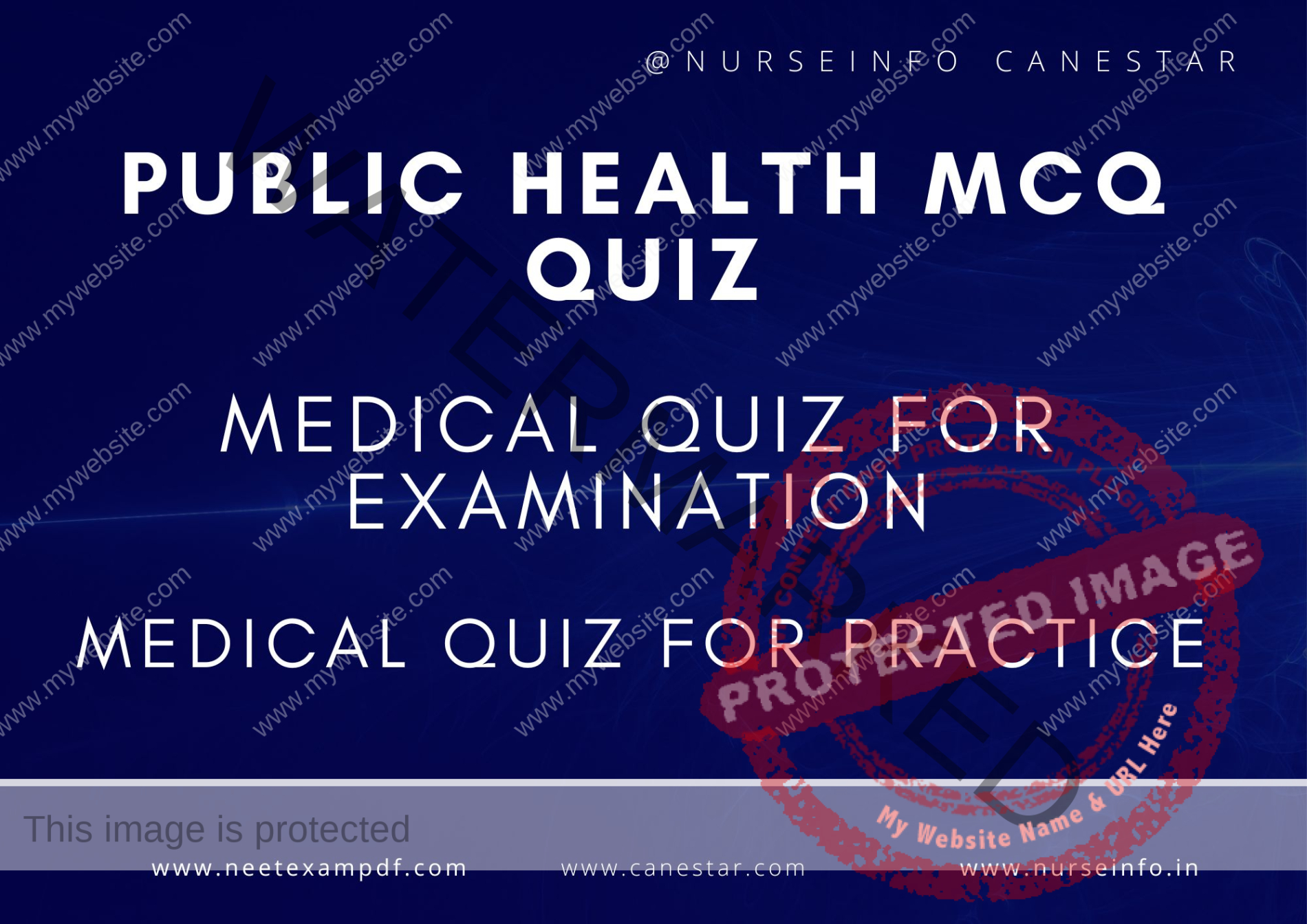MULTIPLE CHOICE QUESTIONS ON PUBLIC HEALTH PRACTICE QUIZ – MCQS WITH RATIONALE ANSWER – PUBLIC HEALTH MCQ QUESTIONS WITH RATIONALE
MCQ FOR PUBLIC HEALTH QUIZ
These mcqs are prepared exclusively for medical professionals for exam preparation. MCQ is helpful to remember the concept on public health mcq quiz. This multiple choice questions are helpful for preparation for DHA, PROMETRIC, MOH, HAAD, NCLEX, Medical, NEET and Nursing EXAMINATION
MCQs on Public Health
What is the primary goal of public health?
A. To treat individual patients
B. To improve the health of populations
C. To conduct laboratory research
D. To provide emergency medical services
Answer: B. To improve the health of populations
Rationale: The primary goal of public health is to improve and protect the health of entire populations through preventive measures, health education, policy-making, and research. Unlike clinical medicine, which focuses on treating individual patients, public health aims to prevent health problems on a community or population level.
Which of the following is a core function of public health?
A. Diagnosis and treatment
B. Assurance
C. Surgery
D. Rehabilitation
Answer: B. Assurance
Rationale: Assurance is one of the three core functions of public health, alongside assessment and policy development. Assurance involves ensuring that essential community-oriented health services are available and accessible to all individuals in the community.
The concept of “herd immunity” is most closely related to which public health intervention?
A. Water fluoridation
B. Vaccination
C. Health education
D. Screening programs
Answer: B. Vaccination
Rationale: Herd immunity occurs when a significant portion of a population becomes immune to an infectious disease, thereby reducing the likelihood of disease spread. Vaccination is a key public health intervention that helps achieve herd immunity.
Which of the following diseases is NOT typically associated with a lack of sanitation?
A. Cholera
B. Typhoid fever
C. Malaria
D. Hepatitis A
Answer: C. Malaria
Rationale: Malaria is primarily transmitted by mosquitoes and is not directly related to sanitation. In contrast, diseases like cholera, typhoid fever, and hepatitis A are often linked to poor sanitation and contaminated water.
What is the leading cause of death worldwide?
A. Cancer
B. Cardiovascular diseases
C. Infectious diseases
D. Accidents
Answer: B. Cardiovascular diseases
Rationale: Cardiovascular diseases, including heart disease and stroke, are the leading cause of death globally. They account for a significant proportion of mortality in both developed and developing countries.
The “epidemiologic transition” refers to:
A. The change from infectious to chronic diseases as the primary cause of death
B. The emergence of new infectious diseases
C. The shift in population demographics
D. The rise in health care costs
Answer: A. The change from infectious to chronic diseases as the primary cause of death
Rationale: The epidemiologic transition describes the shift from a pattern of high prevalence of infectious diseases and high mortality to a pattern where chronic, non-communicable diseases predominate.
Which of the following is considered a social determinant of health?
A. Genetic predisposition
B. Healthcare access
C. Age
D. Gender
Answer: B. Healthcare access
Rationale: Social determinants of health are conditions in the environments in which people are born, live, learn, work, play, worship, and age. These include factors like healthcare access, socioeconomic status, education, and physical environment.
Which organization is primarily responsible for international public health?
A. CDC
B. WHO
C. NIH
D. UNICEF
Answer: B. WHO
Rationale: The World Health Organization (WHO) is a specialized agency of the United Nations responsible for international public health. It coordinates global health responses, conducts research, and provides guidelines and support to countries.
What is a key strategy in primary prevention?
A. Early diagnosis and treatment
B. Health promotion and disease prevention
C. Rehabilitation and physical therapy
D. Palliative care
Answer: B. Health promotion and disease prevention
Rationale: Primary prevention aims to prevent disease or injury before it occurs by promoting healthy behaviors and creating environments that support health, such as vaccination programs, health education, and legislation to reduce exposure to hazards.
Which of the following is an example of secondary prevention?
A. Immunization
B. Screening for high blood pressure
C. Physical therapy for stroke patients
D. Hospice care
Answer: B. Screening for high blood pressure
Rationale: Secondary prevention involves the early detection of disease or risk factors and intervening to prevent progression. Screening for high blood pressure is a secondary prevention strategy to identify and manage hypertension early.
The Global Burden of Disease study is conducted by which organization?
A. World Health Organization (WHO)
B. Centers for Disease Control and Prevention (CDC)
C. World Bank
D. Institute for Health Metrics and Evaluation (IHME)
Answer: D. Institute for Health Metrics and Evaluation (IHME)
Rationale: The Global Burden of Disease study is conducted by the Institute for Health Metrics and Evaluation (IHME). It provides comprehensive data on the impact of diseases, injuries, and risk factors worldwide.
Which of the following is a key indicator of nutritional status in a population?
A. Birth rate
B. Life expectancy
C. Infant mortality rate
D. Body Mass Index (BMI)
Answer: D. Body Mass Index (BMI)
Rationale: Body Mass Index (BMI) is a key indicator used to assess nutritional status in a population. It helps to identify underweight, overweight, and obesity, which are critical factors in public health nutrition.
What is the primary purpose of health impact assessments (HIAs)?
A. To diagnose diseases in a population
B. To predict the health consequences of policies and projects
C. To provide medical treatment to individuals
D. To measure health outcomes
Answer: B. To predict the health consequences of policies and projects
Rationale: Health impact assessments (HIAs) are used to evaluate the potential health effects of policies, plans, programs, and projects in various sectors. They aim to inform decision-makers and stakeholders about the health implications and promote health-positive outcomes.
Which public health intervention is most effective in reducing tobacco-related diseases?
A. Screening for lung cancer
B. Smoking cessation programs
C. Chemotherapy for lung cancer patients
D. Palliative care for advanced cancer patients
Answer: B. Smoking cessation programs
Rationale: Smoking cessation programs are the most effective public health intervention to reduce tobacco-related diseases. These programs help individuals quit smoking, which significantly lowers their risk of developing smoking-related illnesses such as lung cancer and cardiovascular diseases.
The concept of “One Health” refers to the interconnectedness of which three areas?
A. Human health, animal health, and environmental health
B. Physical health, mental health, and social health
C. Public health, clinical medicine, and health policy
D. Preventive health, curative health, and palliative health
Answer: A. Human health, animal health, and environmental health
Rationale: The “One Health” concept emphasizes the interconnectedness of human health, animal health, and environmental health. It recognizes that the health of people is closely linked to the health of animals and the environment, promoting a collaborative approach to achieve optimal health outcomes.
Which of the following is a measure of the incidence of a disease?
A. Prevalence
B. Mortality rate
C. Incidence rate
D. Case fatality rate
Answer: C. Incidence rate
Rationale: The incidence rate measures the occurrence of new cases of a disease in a population over a specific period. It is used to assess the risk of developing the disease and to monitor the effectiveness of public health interventions.
What is the main purpose of quarantine in public health?
A. To provide medical treatment
B. To isolate healthy individuals
C. To prevent the spread of infectious diseases
D. To collect epidemiological data
Answer: C. To prevent the spread of infectious diseases
Rationale: Quarantine involves separating and restricting the movement of individuals who may have been exposed to an infectious disease to prevent its spread. It is a critical public health measure used to control outbreaks and protect the population.
Which type of study design is considered the gold standard for evaluating the effectiveness of a new treatment or intervention?
A. Case-control study
B. Cohort study
C. Cross-sectional study
D. Randomized controlled trial (RCT)
Answer: D. Randomized controlled trial (RCT)
Rationale: Randomized controlled trials (RCTs) are considered the gold standard for evaluating the effectiveness of new treatments or interventions. They randomly assign participants to intervention or control groups, allowing for a high level of control over confounding variables and bias.
What is the main focus of epidemiology?
A. Diagnosis and treatment of diseases
B. Study of the distribution and determinants of health-related states
C. Development of medical technologies
D. Provision of healthcare services
Answer: B. Study of the distribution and determinants of health-related states
Rationale: Epidemiology is the study of the distribution and determinants of health-related states or events in populations. It aims to understand the patterns, causes, and effects of health and disease conditions, guiding public health actions and policies.
Which of the following best describes a social determinant of health?
A. Genetic predisposition
B. Lifestyle choices
C. Economic and social conditions
D. Access to healthcare
Answer: C. Economic and social conditions
Rationale: Social determinants of health are the economic and social conditions that influence individual and group differences in health status. These include factors such as income, education, employment, social support, and community safety, which significantly impact health outcomes.


